Ijraset Journal For Research in Applied Science and Engineering Technology
- Home / Ijraset
- On This Page
- Introduction
- Conclusion
- References
- Copyright
A Study of Lean Six Sigma Implementation for Operation Excellence
Authors: Prabhat Kumar , Dr Gaurav Gupta
DOI Link: https://doi.org/10.22214/ijraset.2024.61131
Certificate: View Certificate
Abstract
Introduction
I. INTRODUCTION
Operations-based businesses face relentless pressure to enhance performance in today's fast- paced business environment. The pursuit of operational excellence has transcended from a mere luxury to a critical survival necessity in the contemporary corporate landscape. This strategic objective mandates the optimization of productivity levels, the strategic reduction of inefficiencies and waste, and the ongoing commitment to delivering top-tier goods and services to clients. The realization of operational excellence yields multifaceted benefits, including heightened profitability, enhanced customer satisfaction, and a significant competitive advantage in the market. By seamlessly integrating these operational strategies into their business models, companies can position themselves as industry leaders while cementing their long-term success in an increasingly dynamic and competitive business world.
II. LEAN SIX SIGMA: A CATALYST FOR TRANSFORMATION
Lean Six Sigma (LSS) is widely recognized as a highly effective methodology that has continually surged in popularity within the realm of operational management for businesses. This approach is meticulously designed to assist organizations specializing in operations to attain an unmatched level of operational excellence, making it an indispensable tool in modern business strategies. By seamlessly integrating two of the most renowned ideologies in business improvement, Lean Six Sigma elevates the efficiency and productivity of operations-based businesses to unprecedented heights. With a careful blend of Lean principles, which focus on eliminating waste and maximizing value, and Six Sigma methodologies, which seek to reduce defects and variations, this approach creates a powerhouse of strategies that streamlines processes and enhances performance across all organizational levels.
Comprehensively intertwining Lean principles and Six Sigma methodologies brings forth a comprehensive approach that addresses not only the immediate needs of businesses but also fosters a culture of continuous improvement and innovation. This calculated fusion ensures that businesses not only achieve short-term gains in efficiency and productivity but also lay a strong foundation for long-term success and sustainability. Through Lean Six Sigma, organizations are equipped with the tools and techniques necessary to optimize processes, enhance quality, and foster a culture of data-driven decision-making. This powerful combination enables operations-based businesses to identify and eliminate inefficiencies, thereby improving customer satisfaction, reducing costs, and ultimately driving profitability.
Furthermore, the incorporation of Lean Six Sigma principles instils a mindset of disciplined problem-solving and systematic process improvement throughout the organizational fabric. By promoting a data-driven and customer-centric approach to decision-making, businesses can align their operations with the ever-evolving needs and expectations of their target market. This not only enhances the overall competitiveness of the organization but also lays the groundwork for sustained growth and success in a rapidly changing business landscape.
In essence, Lean Six Sigma serves as a strategic framework that empowers operations-based businesses to remain agile, adaptive, and resilient in the face of complex challenges and dynamic market conditions.
Lean Manufacturing is a business approach that revolves around optimizing operational processes to eliminate inefficiencies, which are referred to as waste since they fail to add value for the end consumer. The core principles of Lean Manufacturing emphasize the active participation of employees in identifying areas for improvement, the implementation of streamlined and effective procedures, and the ongoing pursuit of enhancements to ensure continuous progress. By fostering a culture of engagement and empowerment among workers, Lean Manufacturing aims to drive organizational efficiency and customer satisfaction by identifying and eliminating non-value-adding activities throughout the production chain.
Contrastingly, Six Sigma is a systematic methodology that prioritizes controlling the variation in processes and reducing defects to a minimum. The central objective of Six Sigma is to enhance process performance and product quality by employing rigorous statistical analysis to pinpoint and rectify operational issues.
Through the rigorous application of data-driven tools and methodologies, Six Sigma enables organizations to achieve heightened levels of consistency and precision in their operations, resulting in enhanced customer satisfaction and improved overall efficiency and effectiveness.
In summary, while Lean Manufacturing focuses on maximizing operational efficiency through waste elimination and process optimization, Six Sigma places a strong emphasis on statistical analysis and defect reduction to enhance product quality and consistency. Both methodologies share the common goal of driving continuous improvement in organizations, albeit through different strategic approaches tailored to their respective strengths and objectives. By integrating the principles of Lean Manufacturing and Six Sigma, businesses can harness a powerful framework for achieving sustainable success and competitive advantage in today's dynamic and demanding marketplace.
Combining the methodical approach of Six Sigma with the principles of Lean manufacturing results in the powerful process improvement methodology known as Lean Six Sigma (LSS). When organizations adopt a Lean Six Sigma approach, they are equipping themselves with a holistic toolset that enables them to achieve significant enhancements in both efficiency and quality. By leveraging Six Sigma's array of analytical tools and statistical methods, businesses can accurately measure process performance and pinpoint areas for improvement with precision.
On the other hand, the Lean methodology brings to the table a focus on optimizing processes by identifying and eliminating various forms of waste, such as unnecessary steps, overproduction, and waiting times. This emphasis on waste reduction not only streamlines operations but also contributes to cost savings and shorter lead times, making the overall business processes more agile and responsive to market demands.
Notably, the integration of Lean principles with Six Sigma techniques enhances the overall effectiveness of process improvement initiatives. By combining the analytical rigor of Six Sigma with Lean's emphasis on continuous improvement and value creation, Lean Six Sigma offers a comprehensive toolkit that can address a broad spectrum of operational challenges inherent in businesses, particularly those that rely on manufacturing or operational processes.
Furthermore, the collaborative nature of Lean Six Sigma fosters a culture of continuous improvement within organizations. Employees at all levels are encouraged to actively participate in problem-solving and process optimization efforts, leading to a more engaged workforce and a shared commitment to delivering enhanced results. This cultural shift towards data-driven decision-making and proactive problem-solving not only boosts operational efficiency but also cultivates a sense of ownership and accountability among employees, thereby creating a sustainable framework for ongoing improvement and innovation.
Given its multifaceted approach and proven track record in driving measurable results, Lean Six Sigma has emerged as a go-to methodology for businesses seeking to achieve operational excellence and sustained competitive advantage. Its ability to blend structured problem- solving methodologies with a focus on waste elimination and value creation positions Lean Six Sigma as a versatile and adaptable tool for enhancing business processes and driving performance improvement across various industries and sectors.

III. LITERATURE REVIEW
In today's fiercely competitive business landscape, achieving operational excellence has become an essential goal for organizations, particularly those whose core functions rely heavily on operational efficiency. The imperative to fine-tune operational processes has
been underscored by a McKinsey & Company study published in the McKinsey Quarterly in 2018 titled "A digital revolution in manufacturing". According to this study, businesses that embrace operational excellence could potentially witness a substantial upsurge in productivity, with the ability to enhance their output by as much as 20%. This heightened efficiency not only leads to increased productivity but also translates into substantial financial gains for companies that prioritize operational excellence. By optimizing their operational frameworks and processes, organizations can navigate the choppy waters of competition with more agility and robustness, thus securing a competitive edge in their respective industries. The quest for operational excellence is not merely an option but rather a strategic necessity in today's cutthroat environment, where every fraction of improved efficiency can contribute significantly to a company's bottom line. The promise of operational excellence lies not just in boosting productivity figures but also in fostering a culture of innovation and continuous improvement within the organizational fabric.
Embracing this ethos of operational excellence equips enterprises with the tools and strategies needed to adapt, thrive, and excel in the face of rapid market changes and evolving consumer demands.
A set of structured directives and methodologies collectively referred to as "operational excellence" is strategically designed with the primary objective of enhancing operational efficiency, streamlining processes, eliminating inefficiencies, and perpetuating a culture of continuous improvement within organizations. The implementation of these guidelines and frameworks aims to foster a work environment that prioritizes optimization, maximizes resource utilization, minimizes operational bottlenecks, and ensures the consistent delivery of exceptional products and services. Through adherence to the principles of operational excellence, businesses can cultivate a competitive advantage, improve overall performance metrics, enhance customer satisfaction levels, and drive sustainable growth. The overarching goal is to establish a foundation for operational excellence that permeates through all facets of the organization, from frontline operations to strategic decision-making, fostering a culture that promotes innovation, collaboration, and adaptability in response to evolving market dynamics. Effectively embedding these principles throughout an organization's operational framework can lead to long-term success, facilitate scalability, and enable the attainment of strategic objectives, ultimately positioning the organization for sustained success and resilience in an ever-changing business landscape. By embracing the ethos of operational excellence, companies can achieve increased operational effectiveness, heightened agility, enhanced responsiveness to market demands, and ultimately, deliver unparalleled value to stakeholders while maintaining a keen focus on driving measurable outcomes and sustainable results.
Increased profitability is a key goal for any business wishing to thrive in a competitive market. One effective way to achieve this is by streamlining operations to reduce expenses and optimize resource utilization. This approach not only cuts costs but also enables the company to operate more efficiently and effectively, ultimately leading to improved profit margins and financial performance overall. By enhancing operational efficiency, a company can allocate its resources more strategically, improving productivity and supporting revenue growth.
Customer satisfaction is another crucial aspect of a successful business. When customers are pleased with the products or services they receive, they are more likely to become repeat buyers and recommend the company to others. Reliable quality and timely delivery are two factors that greatly contribute to customer satisfaction. Consistently meeting or exceeding customer expectations builds trust and loyalty, creating a positive reputation for the business and attracting more customers through word-of-mouth recommendations.
Developing a competitive advantage is essential for businesses looking to differentiate themselves in the marketplace. Operational excellence plays a vital role in achieving this by enabling companies to deliver higher quality products or services, faster turnaround times, and competitive pricing. By continuously improving operational processes, a company can stay ahead of the competition, attract more customers, and secure a stronger market position. This competitive edge can be a key factor in sustainable growth and long-term success in today's fast-paced business environment.
Six Sigma is a data-driven methodology renowned for its focus on managing process variation and reducing defects, as highlighted by research conducted by Pande, Cavanagh, and Neumann. This methodology has been shown, through studies outlined in the book "The Six Sigma Revolution: How General Electric and Others Reinvent Their Processes" (Free Press, 2000), to have a significant impact on defect reduction and enhancing process efficiency. By utilizing statistical techniques and following a structured DMAIC (Define, Measure, Analyse, Improve, Control) cycle, Six Sigma effectively identifies and eliminates flaws within processes. Its systematic approach not only helps in pinpointing areas for improvement but also ensures sustainable efficiency gains and enhanced quality control measures.
Businesses must prioritize continuous investment in process enhancement to ensure the smooth, efficient, and effective functioning of their operations. In this regard, Lean Six Sigma (LSS) stands out as a widely embraced methodology that integrates Lean management and Six Sigma principles to drive operational excellence (Shah et al., 2008). Notably, Lean management traces its roots to the pioneering Toyota Production System developed in the mid-20th century. This model was later elucidated by thought leaders such as Womack et al. (1990) and Spear and Bowen (1999) to formalize its guiding principles. Building on this foundation, contemporary research characterizes Lean management as a holistic approach comprising various techniques focused on waste elimination. These techniques encompass quality control, preventive maintenance, strategic human resource management, and just-in- time production (Shah and Ward, 2003).
Broadening our perspective, it's evident that the proactive adoption of Lean Six Sigma techniques not only streamlines processes but also fosters a culture of continuous improvement within organizations. By systematically identifying and addressing inefficiencies, companies can enhance productivity, reduce costs, and deliver superior quality products and services to their customers. Ultimately, integrating Lean Six Sigma principles into the fabric of an organization's operations can lead to sustainable competitive advantage and long-term success in today's dynamic business landscape.
Since its inception at Motorola Corporation during the mid-1980s, Six Sigma has gained widespread recognition, with numerous publications dedicated to explaining its techniques and principles. This methodology places significant emphasis on enhancing business processes by reducing variability and defects. Six Sigma is a well-structured and systematic approach to improving processes, relying on the application of scientific methodologies and statistical tools to bring about substantial enhancements (Linderman et al., 2003). The framework of Six Sigma, known for its five-phase approach showcased through the Define, Measure, Analyse, Improve, and Control (DMAIC) cycle (Zu et al., 2008), serves as a clear representation of the meticulous nature of this methodology. Through the DMAIC cycle, organizations are guided in a detailed progression, starting from defining project goals and customer requirements, measuring current process performance, analysing data to identify root causes of defects, implementing improvements based on data-driven decisions, and finally, establishing control mechanisms to ensure sustained process improvements. This structured and data-centric methodology ingrained in Six Sigma has proven to be a valuable tool for businesses seeking to drive continuous improvement and achieve exceptional quality standards in their operations.
Clarifying the key success factors (CSFs) required for the successful execution of Lean Six Sigma (LSS) projects has been a primary area of focus in academic studies and scholarly research within the field. Through comprehensive investigations and analyses, various dimensions have emerged as significant contributors to achieving success in LSS projects. Leading researchers such as Schroeder et al. (2008), Choo et al. (2007a), Linderman et al. (2006), and Hagen (2010) have documented essential CSFs that underpin successful project implementation. Additionally, the utilization of structured methodologies has been identified as a pivotal element in project effectiveness by scholars and practitioners alike.
Moreover, beyond the considerations, several other critical success factors continue to surface as fundamental drivers of project success. A crucial aspect involves the establishment of ambitious and clearly defined objectives that promote knowledge creation and foster a culture of continuous innovation within project teams. Furthermore, the provision of adequate coaching and support mechanisms for project team members plays a vital role in enhancing team performance and ensuring the achievement of project goals. Addressing the importance of psychological safety within project teams is another noteworthy factor that contributes to overall team cohesion and productivity.
In essence, the identification and understanding of key success factors in LSS projects represent a cornerstone of scholarly research, with various scholars and experts highlighting the significance of factors such as structured methodologies, goal clarity, coaching support, and psychological safety. These elements collectively shape the trajectory of LSS projects towards successful outcomes and underscore the critical importance of integrating these factors into project management practices to drive continuous improvement and excellence in organizational performance.
Various research studies have delved into the critical success factors (CSFs) essential for the effective implementation of Lean Six Sigma (LSS) and other improvement programs. Noteworthy contributions by scholars such as Netland (2016) and Raval et al. (2018) have extensively explored this area. Their in-depth analyses have provided valuable insights into the factors that are key to the success of LSS initiatives and related strategies.
Specifically focusing on Lean Six Sigma, Sreedharan et al. (2018) undertook a comprehensive review of literature to identify and outline ten essential CSFs that play a pivotal role in the success of Lean, Six Sigma, or Lean Six Sigma endeavours. These identified factors serve as guiding principles for organizations looking to adopt and leverage the principles of Lean Six Sigma to drive continuous improvement and achieve operational excellence.
The insights derived from these studies offer practical guidance for companies seeking to implement Lean Six Sigma methodologies effectively. By understanding and prioritizing these key success factors, organizations can enhance their chances of success in streamlining processes, reducing waste, improving quality, and ultimately achieving sustainable business growth. The meticulous research conducted by these scholars reinforces the importance of aligning organizational goals with the identified CSFs to drive successful Lean Six Sigma transformations and realize tangible business outcomes.
To achieve success in Lean Six Sigma projects, it is essential to focus on a variety of critical success factors. Firstly, it is crucial to emphasize the adoption of structured approaches to project execution and the utilization of statistical tools and techniques that can help in analysing data effectively. Additionally, providing training and educational programs to employees can significantly enhance their skills and contribute to the overall success of the projects. Effective communication within the organization is paramount, ensuring that all stakeholders are well-informed and aligned with the project objectives, particularly by focusing on customer needs and feedback.
Furthermore, transforming the organizational culture to embrace continuous improvement and innovation is key to sustaining success in Lean Six Sigma initiatives. This can be achieved through the active involvement of employees, improvement specialists, and suppliers in the projects, fostering collaboration and shared accountability. Moreover, establishing an organizational infrastructure that supports the clear linkage of Lean Six Sigma projects to the business strategy can help in prioritizing efforts and resources effectively.
By focusing on these critical success factors, organizations can create a strong foundation for the successful implementation of Lean Six Sigma methodologies, ultimately leading to improved operational efficiency, enhanced customer satisfaction, and sustained business growth.
Sreedharan and colleagues (2018) conducted an in-depth assessment of existing literature, shedding light on the critical success factors (CSFs) crucial for the effective implementation of Lean, Six Sigma, or Lean Six Sigma methodologies. Their findings underscore a striking consistency across various studies regarding the key determinants that fuel the success of such initiatives.
Among the pivotal factors highlighted in their research are as follows:
- Demonstrated unwavering commitment and robust support from top-tier management plays a foundational role in the success of these initiatives. This commitment sets the tone for organizational buy-in and sets the stage for sustainable improvement efforts.
- The provision of comprehensive and targeted instruction, coupled with empowering training programs, is essential for cultivating a workforce armed with the knowledge and skills needed to navigate the complexities of Lean, Six Sigma, or Lean Six Sigma frameworks effectively.
- Facilitating transparent and efficient internal communication channels within the organization fosters a cohesive environment where information flows freely, ensuring alignment and unity of purpose throughout the implementation process.
- Defining project objectives that intricately align with the evolving needs and expectations of clients is imperative for driving meaningful outcomes and ensuring that improvement initiatives yield tangible benefits for all stakeholders involved.
- Emphasizing the need to instigate a transformative shift in organizational culture underscores the significance of nurturing a culture that embraces continuous improvement, innovation, and adaptability.
- Encouraging active participation from all facets of the organization, including staff members, improvement specialists, and suppliers, fosters a collaborative ethos that fuels collective engagement and ownership over improvement initiatives.
- Executing projects through structured and systematic methodologies ensures that initiatives unfold seamlessly, leveraging organized approaches that streamline processes and enhance overall project efficiency.
- Integrating sophisticated statistical analysis methods and tools into the project framework equips organizations with the capabilities to derive actionable insights, make data-driven decisions, and monitor progress effectively.
- Establishing a robust organizational framework that aligns Lean Six Sigma projects with overarching corporate strategies is pivotal for creating a seamless integration that propels the organization towards strategic objectives and operational excellence.
IV. LEAN SIX SIGMA APPROACH FOR ANALYSIS
Lean Six Sigma (LSS) initiatives are meticulously designed to tackle complex and unstructured issues through the adept utilization of methods for collecting and analysing data, as highlighted by De Mast and Lockerbie in 2012. As organizations delve into Lean Six Sigma practices, the tailored implementation of statistical methodologies tailored to address specific challenges becomes indispensable in executing successful LSS projects. However, amidst the strategic utilization of these statistical tools, it is imperative to recognize data analytics as a vast and evolving field with a rich history.
The roots of data analytics can be traced back to the 1950s, where it made its initial appearance by leveraging limited data sources stored within internal systems, often housed in repositories or data warehouses, as detailed by Davenport in 2014. Initially known as business analytics or business intelligence, the early days of data analytics solutions predominantly revolved around descriptive methods that primarily focused on generating reports and offering decision support, as elucidated by Bartlett in 2013. This historical evolution underscores the enduring importance of not only understanding the current applications of data-analytics-driven decision-making but also acknowledging its lineage and continual advancement over time, shaping the landscape of modern data analytics practices within Lean Six Sigma projects and beyond.
The term "Big Data" emerged on the tech landscape during the early 2000s, marking a pivotal moment in the world of data analytics. In their seminal work, Megahed, and Jones-Farmer (2015) eloquently characterized Big Data as a fusion of massive volume, high velocity, and diverse variety. This revolutionary era witnessed the transformation of digital technology as businesses began harnessing Big Data for intricate internal analyses and profound insights into consumer behaviour.
As the concept of Big Data evolved, it became increasingly apparent that conventional data processing and storage mechanisms were inadequate to keep pace with the deluge of information pouring in. In response to this technological tsunami, innovative algorithms were developed to delve deep into the data reservoirs, birthing the processes of data mining that unlocked a wealth of predictive and prescriptive analytics opportunities (Fayyad et al., 1996). This data-driven paradigm shifts not only revolutionized the way businesses operated but also laid the groundwork for a new era of streamlined decision-making and strategic planning.
Despite the growing recognition and integration of descriptive data visual analytics within the field, highlighted by Davenport (2014), it is crucial to acknowledge the profound impacts that the rise of big data has had on the broader landscape of data analytics. This era of technological advancement has ushered in significant transformations, fundamentally altering the way data is perceived, processed, and utilized. One prevailing trend that has emerged in response to the deluge of data is the accelerated conversion of raw information into actionable insights through sophisticated analytical methodologies. In this light, prescriptive and predictive analysis have ascended in prominence, particularly leveraging machine learning algorithms to extract meaningful patterns and forecast future trends.
Furthermore, as elucidated by Jarr (2015), there is an increasing emphasis on the importance of "fast analytics" facilitated by powerful visualization tools. This shift towards expedited and visually intuitive data analysis signifies a paradigmatic change in how organizations derive value from their data assets. Through the lens of visual analytics, the complexities of data are unravelled, enabling decision-makers to gain deeper insights and make informed choices swiftly. The overarching narrative encapsulates a narrative wherein data visualization becomes a linchpin for driving strategic decision-making processes and fostering a data-driven culture within enterprises across various industries.
The advent of big data has undeniably catalysed a shift towards a more dynamic and agile approach to data analytics, underscoring the need for real-time insights and adaptive methodologies. This transformative juncture in the data analytics landscape beckons a new era of innovation and sophistication, where the convergence of descriptive, prescriptive, and predictive analytics paves the way for a holistic understanding of data-driven decision-making.
As organizations grapple with the deluge of data at their disposal, the efficacy of leveraging visual analytics as a conduit for extracting actionable intelligence becomes increasingly apparent.
In essence, the fusion of data analytics and visualization stands at the vanguard of modern decision-making paradigms, unlocking a realm of possibilities for organizations seeking to harness the power of big data. As we navigate this ever-evolving data-centric landscape, the interdisciplinary interplay between data visualization, analytics, and machine learning emerges as a compelling force shaping the future trajectory of data-driven insights and organizational success. The symbiotic relationship between technology, data, and human expertise heralds a new dawn in the realm of data analytics, where the ability to distil complex datasets into tangible outcomes defines the competitive edge in an era defined by information abundance and technological progress.
Big Data's rapid growth necessitated enhanced processing and storage capabilities to keep up with the increasing demand for quicker data handling. Consequently, specialized algorithms were devised to unearth patterns within data, a process commonly referred to as data mining, which ultimately paved the way for the advent of predictive and prescriptive analytics, as noted by Fayyad et al. in 1996. Amidst these advancements, the usage of descriptive data visual analytics, as highlighted by Davenport in 2014, remained prevalent. The Big Data wave triggered a significant transformation in the realm of data analytics, intensifying the need for swift conversion of data into actionable insights. This surge in demand underscored a heightened focus on leveraging machine learning for prescriptive and predictive analyses, as organizations increasingly sought to extract valuable business intelligence from the data deluge.
In addition to the mentioned trends, it is essential to highlight how the integration of fast analytics driven by visualization has revolutionized data analysis processes in various industries. The adoption of methodologies such as CRISP-DM has played a pivotal role in shaping the structured approach to data mining projects. By allowing for iterative cycles between different phases, this framework has facilitated a more dynamic and efficient analytical workflow. It is worth noting that past research has delved into the synergies between contemporary data analytics strategies and the frameworks of Lean Six Sigma, particularly within the context of the financial services sector. This intersection has unveiled opportunities for enhancing organizational processes and decision-making through a fusion of advanced analytical tools and established quality management methodologies. Overall, the evolving landscape of data analytics continues to present exciting prospects for organizations seeking to leverage data-driven insights for strategic advantage and
operational excellence.
V. RESEARCH METHODOLOGY
In this study, a comprehensive approach involving the integration of diverse research methods will be employed to gather a broad range of both quantitative and qualitative data. This mixed-methods research methodology aims to provide an in-depth understanding of the practical applications and effectiveness of Lean Six Sigma (LSS) for achieving operational excellence within organizational settings. By combining statistical analysis with insightful narratives and feedback from stakeholders, the research will delve into the intricacies of how LSS principles and tools are utilized, their impact on process improvement, and the overall implications for business performance and competitiveness. Through this multidimensional data collection strategy, the study seeks to unearth valuable insights that can inform strategic decision-making, refine best practices, and enhance the implementation of LSS methodologies in real-world scenarios. Results from this mixed-methods investigation are anticipated to illuminate the multifaceted dimensions of operational excellence achieved through the adoption of Lean Six Sigma, thereby contributing to the continuous improvement and sustainability of organizational processes and outcomes.
A. Quantitative Data Collection
A structured online survey is set to be conducted for the managers and employees of Flipkart and Amazon who have actively engaged in Lean Six Sigma (LSS) initiatives. This survey will serve as a platform to collect valuable insights into the specific LSS practices adopted within their respective organizations. The primary focus of the survey will be to delve into the impact of Lean Six Sigma (LSS) methodologies on various crucial operational excellence key performance indicators (KPIs). These key performance indicators include but are not limited to lead time, defect rate, and customer satisfaction metrics. Moreover, the survey aims to capture the opinions, feedback, and experiences of participants with regards to the challenges they face and the effectiveness of implementing Lean Six Sigma (LSS) methodologies in their work environments. Through this comprehensive survey, a deeper understanding of the real-world implications and the practical outcomes of incorporating LSS strategies can be gained, ultimately offering valuable insights into the overall success and effectiveness of Lean Six Sigma practices within the context of these prominent e-commerce organizations.
???????B. Quantitative data analysis
DMAIC Cycle and Numerical Information:
The DMAIC cycle—Define, Measure, Analyse, Improve, Control—is followed by LSS. At each stage, quantitative data is essential:
- Define: Determine which procedure needs to be improved. The scope of the issue can be determined in this case by statistics on failure rates, cycle times, customer complaints, and cost measures.
- Measure: Set benchmarks for performance. Quantifiable information on process parameters such as cycle time fluctuations, defect rates, and prices will be gathered. This data is analysed with the aid of statistical methods such as capability studies and control charts.
- Analyse: Find the sources of problems. The most common flaws and their possible effects are identified using quantitative analytic approaches like Failure Mode and Effects analytic (FMEA) and Pareto charts.
- Enhance: Create and put into action solutions. Pilot run data is used to evaluate how well deployed solutions work. Cycle times, defect rates, and cost savings can all be quantified.
- Control: Keep an eye on and maintain advancements. Control charts are used to track post- implementation process performance and post-implementation and guarantee that these advancements are maintained throughout time.
C. Qualitative Data Analysis's Advantages
Objectivity: Data offers a fact-based method for determining issues, gauging progress, and arriving at data-driven choices.
Measurable Impact: You may verify that LSS initiatives are successful in attaining operational excellence by quantifying improvements.
Comparison & Benchmarking: Performance can be compared before and after LSS implementation thanks to data. Additionally, you can compare your outcomes to industry norms.
???????D. Secondary Data Analysis
The comprehensive scrutiny of the data sourced from the sustainability reports and annual reports of leading e-commerce platforms such as Flipkart and Amazon is being conducted in order to identify discernible trends and correlations within operational performance metrics- for instance, aspects like inventory turnover and order fulfilment speed. This meticulous analysis aims to unveil potential linkages between these performance indicators and the Lean Six Sigma (LSS) initiatives undertaken by the organizations, which could offer valuable insights into how operational efficiency and sustainability efforts intersect and influence each other within the context of these industry giants. As we delve deeper into this examination, we seek to uncover not only the quantitative associations between operational measures and LSS strategies but also to elucidate the qualitative impacts and strategic implications that emerge from the integration of sustainable practices with Lean Six Sigma methodologies in the operations of Flipkart and Amazon. This in-depth exploration is poised to shed light on the intricate interplay between traditional business metrics and innovative sustainability initiatives, offering a nuanced perspective on the evolving landscape of corporate performance measurement and strategic decision-making in the contemporary digital marketplace. Through this research endeavour, we endeavour to contribute to the discourse on driving operational excellence through the synergistic alignment of performance metrics with sustainability imperatives, paving the way for enhanced competitive advantage and long-term success in the ever-evolving e-commerce ecosystem.
???????E. Qualitative Data Collection
Semi-structured Interviews: Comprehensive interviews with significant participants from Amazon and Flipkart, such as LSS champions, process owners, and front-line staff, will be held. Interviews will look at:experiences implementing LSS in their departments or roles.instances of implemented LSS programmes and their effects on operational effectiveness. obstacles faced during execution and solutions used to go beyond them.
F. Using Flipkart and Amazon as Examples
Flipkart and Amazon were selected as case studies because of:
Taking the lead in the e-commerce sector are companies that stand out for their large-scale, operations-driven models, relying significantly on efficient procedures to drive their success. This emphasis on operational excellence is apparent in both Amazon and Flipkart, two key players in the industry. While Amazon is a globally recognized brand known for its robust Lean Six Sigma (LSS) culture, Flipkart, with its primary focus on operations in India, offers a unique perspective on how LSS principles are adapted within a specific geographic context.
Publicly available information sheds light on the efforts made by both companies to enhance their operational efficiencies and sustainability practices. These disclosures can provide valuable insights into the practical applications of Lean Six Sigma within their operations. Amazon's global reach showcases a commitment to the systematic implementation of LSS across various regions and functions, setting a precedent for operational excellence on a massive scale. On the other hand, Flipkart's localized approach offers a nuanced view of how LSS strategies are tailored to suit the specific demands and challenges of the Indian market, highlighting the adaptability and versatility of Lean Six Sigma methodologies.
By examining these contrasting contexts, observers can gain a comprehensive understanding of how companies of different scales and scopes implement LSS principles to streamline their operations and drive continuous improvement. Amazon's strong emphasis on operational efficiency and process optimization mirrors its global stature, while Flipkart's strategic focus on the Indian market underscores the importance of context-specific adaptations in realizing the full potential of Lean Six Sigma methodologies. Combined, these insights provide a rich tapestry of the diverse applications of LSS in the e-commerce landscape, illustrating how companies leverage operational excellence to maintain a competitive edge in an ever- evolving industry.
???????G. Data Analysis
- Quantitative Data Analysis
In the realm of quantitative data analysis, a comprehensive examination will be conducted to unearth intricate trends and correlations existing between Lean Six Sigma (LSS) procedures and the overall operational performance of the organization. This analytical journey will involve the thorough statistical analysis of survey data, delving deep into the numbers to identify patterns and establish any potential relationships between specific LSS procedures and the publicly available performance metrics. Furthermore, emphasizing a more detailed investigation, the core objective of the subsequent data analysis phase will be to unravel the intricate connections existing between various LSS activities and the key performance indicators that are openly accessible. By scrutinizing the data with precision and employing advanced statistical techniques, the focus will be on uncovering noteworthy patterns, discerning significant linkages, and ultimately gaining valuable insights that can contribute to enhancing operational efficiency and effectiveness within the organizational framework.
???????2. Qualitative Data Analysis
To gain a comprehensive understanding of the deployment of Lean Six Sigma (LSS) at Amazon and Flipkart, a thorough thematic analysis will be carried out on the interview transcripts. This detailed examination aims to reveal and highlight any recurring themes, patterns, challenges, as well as positive experiences shared by the participants. Through this methodical analysis, unique insights and valuable perspectives regarding the implementation and impact of LSS in these prominent e-commerce companies will be unearthed. The process will involve meticulously reviewing and scrutinizing the contents of the interviews to identify common threads and notable occurrences related to the integration of LSS strategies. By delving deep into the narratives provided by employees and stakeholders, the study seeks to provide a rich narrative on the successes, hurdles, and overall impressions associated with the adoption of LSS practices at both Amazon and Flipkart. This in-depth exploration is essential to paint a comprehensive picture of the effectiveness and application of Lean Six Sigma in the dynamic and competitive landscapes of these online retail giants, shedding light on the real-world challenges and benefits encountered in this specific context.
???????H. Ethical Considerations
- Prior to conducting surveys or interviews, participants will provide their informed consent.
- All participants will be guaranteed privacy and anonymity.
- Information will be safely kept and utilised only for the study's specified research objectives.
I. Restrictions
There might not be easy access to comprehensive information on LSS projects and internal data at Amazon and Flipkart.
The study's narrow focus on only two businesses restricts its applicability to the larger e- commerce sector.
J. Anticipated Results
The main objective of this study is to delve deeply into the significant insights pertaining to various aspects of Lean Six Sigma implementation within the realm of operational excellence in major online retailers. Specifically, we aim to shed light on the effectiveness of Lean Six Sigma methodologies in elevating operational efficiency within this sector. An in-depth exploration will be conducted to highlight the challenges and successes encountered during the deployment of LSS, drawing examples from the experiences of prominent online retailers such as Amazon and Flipkart. By examining these real-life cases, we seek to provide valuable lessons on both the obstacles to be overcome and the best practices to be embraced when integrating Lean Six Sigma into online retail operations. Furthermore, our study intends to investigate the potential discrepancies in the application and impact of LSS between global e- commerce giants and local online businesses. Through this comparative analysis, we endeavour to discern the unique challenges faced by worldwide versus local e-commerce entities in harnessing the full potential of Lean Six Sigma for operational enhancement. Additionally, we aspire to present practical recommendations and strategies aimed at optimizing the utilization of Lean Six Sigma methodologies to drive operational excellence in similar scenarios. In doing so, we seek to offer actionable insights that can guide online retailers in maximizing the benefits of LSS implementation within their operational frameworks, ultimately leading to enhanced performance and competitiveness in the dynamic e-commerce landscape.
IV. IMPLEMENTING LEAN SIX SIGMA IN ORGANIZATION
A thorough understanding of Lean Six Sigma (LSS) is essential for successful implementation within a company. Before integrating LSS methodologies, it is crucial to grasp the underlying concepts, techniques, and potential benefits that encompass Lean Six Sigma. The primary objectives of LSS revolve around enhancing overall quality, reducing waste, and boosting operational efficiency, creating a robust framework for continuous improvement. By incorporating the principles of Six Sigma, which aims at minimizing defects, and the Lean approach focused on waste elimination, companies can achieve sustainable performance enhancements across their processes.
One crucial aspect of LSS implementation is securing the commitment and backing of organizational leaders. The initiation of an LSS program necessitates firm support from top management, who are responsible for ensuring adequate resource allocation and fostering a culture of ongoing improvement. An organization's success in leveraging Lean Six Sigma practices significantly hinges on strong leadership buy-in and active involvement throughout the implementation phase. Without leadership guidance and championing, challenges may arise, hindering the effectiveness of LSS initiatives and impeding progress towards achieving operational excellence and sustainable business growth.
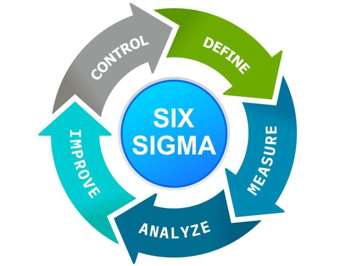
Training and education should be given top priority by the organisation as soon as the leadership commits to it. This prioritization underscores the critical role that upskilling and knowledge acquisition play in fostering a culture of continuous improvement. Emphasizing training sets the stage for unlocking the potential of employees to drive Lean Six Sigma (LSS) initiatives effectively. Black Belts, Green Belts, and Yellow Belts form the backbone of LSS proficiency, with their mastery over tools and methodologies anchoring successful project outcomes.
By allocating resources to support training programs, employers empower their workforce to navigate the complexities of LSS projects with confidence. Well-trained staff members are better equipped to lead initiatives that drive tangible progress within the organization. Through targeted investments in training, companies lay a solid foundation for sustainable improvement efforts while nurturing a cadre of skilled practitioners capable of tackling operational challenges head-on.
Organizations can start identifying possible LSS projects once they have training in place. This strategic approach enables proactive project selection aligned with overarching business objectives. Project discovery should prioritize areas where opportunities for enhancement abound, ensuring that initiatives are tailored to deliver substantial value. From enhancing quality and productivity to optimizing processes, LSS projects are instrumental in propelling organizational growth and competitiveness.
Initiatives ought to be in line with strategic goals and concentrate on areas where there is ample room for development. Aligning projects with the organization's vision and objectives ensures that resources are channelled towards initiatives that yield the greatest impact. Focusing on areas ripe for improvement allows companies to strategically target inefficiencies and bottlenecks, enhancing operational effectiveness and customer satisfaction. By homing in on fault reduction, cycle time acceleration, and process streamlining, organizations fine-tune their operations to achieve peak performance.
Reducing faults, accelerating cycle times, raising customer satisfaction, and streamlining procedures are typical areas of concentration. Tackling these focus areas demands cross- functional collaboration and a holistic approach to problem-solving. Multidisciplinary teams are formed to champion LSS projects, leveraging diverse expertise to dissect processes and unearth root causes of inefficiencies. By bringing together individuals from various departments, organizations foster a culture of collaboration and knowledge sharing, enriching project outcomes with unique perspectives and insights.
Throughout the entire project lifecycle, making informed decisions based on robust data is crucial not only for Lean Six Sigma (LSS) but also for the successful execution of various organizational initiatives. LSS methodology relies on advanced statistical techniques and specialized tools to meticulously analyse data sets, thereby enabling organizations to identify specific areas that require enhancements or modifications. By effectively collecting and evaluating relevant data, organizations have the capacity to thoroughly evaluate the impact of their development strategies and subsequently make well-considered decisions that align with their overarching goals and mission.
Furthermore, an integral aspect of the LSS approach involves the continuous monitoring and feedback mechanism, which serves as a fundamental driver of operational excellence for any organization. To ensure sustainable progress and long-term success, businesses should implement a suite of comprehensive metrics and key performance indicators (KPIs) to rigorously monitor project advancement and secure the consistency of achieved gains over an extended period. Regular performance evaluations and review sessions play a pivotal role in maintaining project timelines and identifying persistent developmental needs, thereby fostering a culture of continuous improvement and adaptive resilience within the organizational framework.
One of the main advantages of Lean Six Sigma (LSS) lies in its inherent capacity to foster and nurture a culture of continual improvement within organizations. By actively engaging employees at all levels and empowering them to contribute to developmental projects, companies can instil a mindset of innovation and excellence throughout their operations.
It is essential to recognize that the implementation of LSS is not a one-time initiative but rather an ongoing journey towards operational excellence. Organizations must steadfastly adhere to the fundamental principles of LSS and continually seek opportunities for enhancement and growth. By embracing a philosophy of perpetual refinement, businesses can not only achieve sustained success but also gain a competitive advantage in today's dynamic and rapidly evolving market landscape.
VII. THE HISTORY AND DEVELOPMENT OF LEAN SIX SIGMA
Lean Six Sigma (LSS) has a rich historical background that traces back to the mid-20th century. During this era, the Lean and Six Sigma methodologies evolved separately before eventually merging into a comprehensive and unified system. The roots of Lean principles can be traced back to the inception of the Toyota Production System (TPS) in the 1950s, pioneered by Toyota. The fundamental aim of TPS was to enhance productivity by eliminating waste, enhancing efficiency, and simplifying processes. This led to the development and propagation of key Lean principles such as just-in-time manufacturing, continuous flow, and respect for people, championed by influential figures like Taiichi Ohno and Shigeo Shingo.
In stark contrast, Six Sigma emerged during the 1980s through the pioneering work of Bill Smith, an engineer at Motorola. Unlike Lean, Six Sigma focused on the reduction of variation and errors in operational processes to achieve a higher level of quality and performance. The amalgamation of Lean and Six Sigma methodologies brought forth a powerful and holistic approach to quality management, enabling organizations to drive continuous improvement, enhance customer satisfaction, and achieve operational excellence. This integration of Lean and Six Sigma principles has become a cornerstone in the realm of process improvement and organizational efficiency, fostering a culture of innovation and continuous learning that is essential for thriving in today's competitive business landscape.
In the latter half of the 20th century, Lean and Six Sigma integration with Lean Six Sigma (LSS) began to gain significant momentum. A notable turning point occurred when forward-thinking businesses, such as General Electric, Toyota, and Motorola, recognized the synergies between these two methodologies and decided to merge them. This strategic decision led to a remarkable surge in operational efficiency and performance across various industries.
Among these pioneering companies, Motorola emerged as a trailblazer by formalizing the powerful DMAIC (Define, Measure, Analyse, Improve, Control) methodology for driving process improvements. The adoption of both Lean and Six Sigma principles within the DMAIC framework presented a structured and systematic approach to pinpointing inefficiencies, analysing root causes, and implementing solutions to eliminate waste and defects within organizational processes.
Comprehensively, this integration of Lean and Six Sigma within the Lean Six Sigma (LSS) paradigm not only propelled Motorola to the forefront of process excellence but also set a benchmark for other organizations looking to achieve remarkable advancements in operational effectiveness.
Through the disciplined application of DMAIC and a relentless commitment to continuous improvement, businesses were able to enhance their competitive edge, drive innovation, and deliver superior value to customers.
The evolution of LSS continued beyond the turn of the millennium, with its application extending into various sectors beyond manufacturing, including services, finance, and healthcare. Through the late 1990s and early 2000s, the proven efficacy of LSS in enhancing customer satisfaction, reducing costs, and enhancing quality was the driving force behind its penetration into these realms.
Furthermore, the trajectory of LSS has been significantly influenced by the forces of globalization and continuous technological advancements. The rise of digital tools like automation and data analytics has revolutionized the way organizations adopt LSS methodologies, enabling more efficient implementation and monitoring of process improvements. This integration of technology has accelerated the pace at which LSS practices are embraced across industries, further solidifying its position as a premier operational strategy.
In today's hyper-connected and fiercely competitive global landscape, organizations are compelled to embrace continuous improvement and innovation to stay ahead. This pressing need for agility and efficiency has propelled the ongoing evolution of LSS as companies seek new ways to enhance their competitiveness and meet the evolving demands of the market. Amidst these trends, the foundational principles of Six Sigma and Lean remain instrumental in guiding businesses towards operational excellence and sustainable growth.
VIII. SUCCESS FACTORS AND CHALLENGES
Implementing Lean Six Sigma (LSS) is a multifaceted and intricate endeavour that demands meticulous planning, adept leadership, and adept change management strategies. It is a process where companies must undergo thorough preparation and navigate through various challenges to attain operational excellence and efficiency enhancements. Despite the promising benefits of LSS implementation, organizations often encounter numerous obstacles and setbacks that test their resilience and adaptability. In this section, we delve into the pivotal components crucial for a successful deployment of LSS, while also shedding light on the common hurdles that organizations confront along the way.
A. Success Elements
One fundamental success element pivotal for LSS implementation success is undeniably Leadership Support and Commitment. Firm and unwavering backing from top management is paramount for driving the change initiative forward. Leaders must not only endorse the LSS methodology but actively participate in its advancement by allocating resources and involving themselves in process improvements to demonstrate their genuine support and dedication.
Additionally, another crucial determinant of success in LSS endeavours is Employee Engagement. Engaging employees at all organizational levels is indispensable for the triumph of LSS projects. From frontline staff to senior executives, everyone must be encouraged to actively participate in problem-solving activities and be empowered to contribute their insights and expertise towards optimizing processes and driving continuous improvement initiatives within the organization. Engaging employees not only fosters a culture of collaboration and innovation but also ensures that diverse perspectives are considered in the improvement efforts, thereby enhancing the likelihood of achieving sustainable results and fostering organizational excellence.
B. Challenges and Barriers
Resistance to Change: One of the most common challenges encountered during the implementation of Lean Six Sigma (LSS) initiatives within organizations is resistance to change. This reluctance to embrace new procedures, tools, or methodologies often stems from employees' concerns about potential changes to their roles, discomfort with the unfamiliar, or scepticism towards the promised benefits of Lean Six Sigma practices. Addressing this resistance requires comprehensive change management strategies that not only communicate the value and purpose of LSS but also involve employees in the transformation process, allowing them to understand, engage with, and contribute to the success of the initiatives.
Absence of Leadership Support: In the absence of robust leadership support, Lean Six Sigma efforts are at risk of facing significant hurdles on the path to achievement. Leaders who fail to fully commit to the process may hinder progress by withholding financial resources, failing to prioritize LSS projects adequately, or even undermining the credibility and legitimacy of Lean Six Sigma endeavours. To overcome this obstacle, organizations must cultivate a culture of leadership buy-in, where executives and managers not only endorse LSS but actively champion its principles, allocate resources effectively, and set clear expectations for their teams to follow suit.
Organisational Silos: The presence of organizational silos can impede the seamless implementation of Lean Six Sigma methodologies by creating barriers to inter-departmental collaboration and communication. These silos, fuelled by departmental autonomy and lack of cross-functional alignment, can hinder the sharing of insights, best practices, and resources essential for successful LSS projects. To foster a more cohesive and integrated approach to continuous improvement, organizations must break down these silos, promote a culture of cross-functional teamwork, and encourage open communication channels that allow for the free flow of information and collaboration across all levels and departments.
Six Sigma Scatter Plot
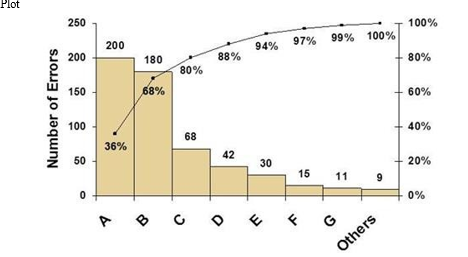
???????IX. THE IMPLEMENTATION OF LEAN SIX SIGMA AT AMAZON: A CASE STUDY
Amazon, which stands as the world's largest online retailer, has consistently positioned itself as a trailblazer in the realms of technology and forward-thinking business strategies. Over the years, the company's remarkable achievements can be significantly attributed to its diligent incorporation of Lean Six Sigma principles. This approach harmoniously merges the quality- centred principles of Six Sigma with the waste-eliminating ethos of Lean methodology, creating a robust framework for operational excellence. By meticulously applying Lean Six Sigma techniques to its operations, Amazon has not only fine-tuned its processes but also fortified its competitive prowess in the dynamic market landscape. This detailed examination will delve into how Amazon strategically optimized its operational efficiency and perpetuated its market dominance through the systematic deployment of the
Lean Six Sigma methodology.
Lean Six Sigma implementation at Amazon has significantly transformed the company's approach to various aspects of its operations. From the management of storage, shipping, and receiving to optimizing customer support services and enhancing the efficiency of its cloud computing offerings, Amazon has fully embraced Lean Six Sigma principles to navigate the complexities of its vast array of services.
One striking example illustrating the successful application of Lean principles at Amazon is the streamlining of its fulfilment centres, more commonly known as warehouses. Through continuous improvement initiatives driven by Lean Six Sigma methodologies, Amazon has successfully minimized process waste and heightened operational efficiency within these vital hubs. A key strategy employed by Amazon in this regard has been the strategic reconfiguration of the fulfilment centre layouts to reduce waiting times during packaging and delivery processes. By organizing products in a systematic manner that aligns with order frequency patterns, Amazon has significantly reduced the time spent by workers in locating and retrieving items, thus enhancing overall productivity levels.
Furthermore, Amazon's adoption of the renowned "5S" methodology, encompassing the principles of Sort, Set in Order, Shine, Standardize, and Sustain, has played a pivotal role in sustaining the efficiency gains achieved through Lean Six Sigma implementation. By actively incorporating these fundamental Lean techniques into its day-to-day operations, Amazon has fostered a culture of continuous improvement and operational excellence that is deeply ingrained across all facets of the organization.
In essence, Lean Six Sigma implementation at Amazon serves as a testament to the company's unwavering commitment to delivering exceptional quality, optimizing operational processes, and ensuring unparalleled customer satisfaction. Through the strategic integration of Lean principles into its operational framework, Amazon continues to set new benchmarks in efficiency, productivity, and overall organizational performance, thereby solidifying its position as a global leader in e-commerce and cloud computing services.
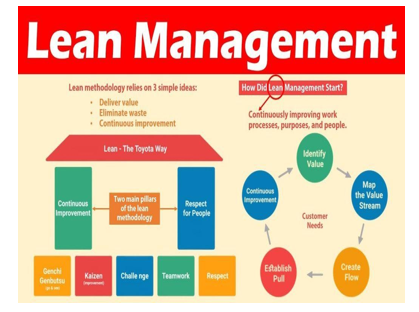
Furthermore, in addition to using Six Sigma methodologies to enhance the calibre of its business processes, Amazon also heavily invests in refining the customer service experience it delivers. The systematic approach employed by Amazon, known as Define, Measure, Analyse, Improve, Control (DMAIC), plays a pivotal role in ensuring that errors are minimized, and customer satisfaction is maximized. This methodical technique involves a comprehensive evaluation of customer satisfaction levels before any changes are implemented. By accurately identifying areas of concern and delving into the root causes of dissatisfaction, Amazon can make informed adjustments that resonate well with their customer base. To maintain the highest standards of excellence, Amazon meticulously monitors and controls the newly implemented procedures.
Moreover, the application of Lean Six Sigma principles extends beyond just business processes and into the realm of shipping logistics at Amazon. The company harnesses the power of advanced data analytics to optimize delivery routes and reduce transport times significantly. This strategic use of Lean Six Sigma tools not only eliminates inefficiencies but also plays a fundamental role in elevating customer satisfaction levels. By employing a data-driven approach to streamline their shipping operations, Amazon showcases its commitment to enhancing the overall customer experience through efficient and reliable order fulfilment processes.
creating a work environment driven by innovation and efficiency. By fostering a culture of continuous improvement, Lean Six Sigma has empowered employees at Amazon to actively seek out opportunities for enhancement across all operational levels. This proactive approach encourages inventive problem-solving and a commitment to excellence, propelling Amazon to the forefront of business innovation.
Moreover, the successful application of Lean Six Sigma tools and methodologies at Amazon has not only enhanced operational efficiency but has also driven significant cost savings. Streamlining processes and minimizing waste have led to a reduction in operating expenses, enabling Amazon to allocate resources more strategically and invest in future growth opportunities.
Additionally, the systematic approach of Lean Six Sigma has enabled Amazon to identify and address root causes of inefficiencies, resulting in sustainable improvements that have a long- lasting impact on the business. By leveraging data-driven insights and implementing targeted solutions, Amazon has been able to continuously optimize its processes and deliver superior results to its customers.
In conclusion, the application of Lean Six Sigma principles at Amazon has brought about transformative outcomes by improving productivity, enhancing quality, fostering a culture of innovation, driving cost savings, and ensuring sustainable operational excellence. Through a strategic and principled approach to process improvement, Amazon has solidified its position as a leader in the e-commerce industry and continues to set new standards for operational effectiveness and customer satisfaction.

One day, a Six Sigma trainer at Amazon asked Jeff Bezos, "Why do I sweep? Why don't I remove the dirt's source instead?" This question not only sparked a conversation about operational efficiency but also led to the exploration of innovative solutions within lean principles.
Andon, a fundamental concept in Lean Six Sigma, is recognized as a visual management solution that plays a pivotal role in streamlining operations by identifying and eliminating bottlenecks that impede productivity and efficiency.
In the realm of Japanese culture, the traditional paper lantern known as an Andon cord has symbolic significance. Interestingly, this concept aligns with the principle of "Judoka," emphasizing the empowerment of employees through the implementation of an Andon system aimed at improving overall operational performance.
By integrating an Andon system, workplace transparency is enhanced, leading to increased productivity within specified timelines. Moreover, this system fosters adaptability by granting employees more autonomy in decision-making processes, thereby enabling them to address and resolve issues promptly.
One of the primary advantages of an Andon system is its ability to minimize downtime required for troubleshooting and issue resolution, ultimately contributing to a more streamlined workflow and operational efficiency. Furthermore, by setting higher standards of work and empowering employees to take charge, costs can be reduced while maintaining quality output.
Yearly, tens of thousands of defects are effectively rectified through the utilization of the Andon cord, underscoring its substantial impact on operational excellence and continuous improvement initiatives.
Considering these principles, Amazon has embraced the philosophy that persistent flaws or issues identified in the customer support system should be addressed promptly. By engaging employees in a culture of problem-solving and continuous improvement, Amazon ensures that customer satisfaction remains a top priority while striving for operational excellence.
With the application of Six Sigma, they sought to accomplish the following four objectives:
- Standardized processes
To streamline operations and enhance overall efficiency, AWS dedicated significant resources to establish standardized processes that spanned across their diverse array of service offerings. Through a meticulous examination of workflows within the organization, they pinpointed areas of inconsistency and subsequently devised a set of uniform procedures aimed at ensuring steadfast quality and performance across the board. The implementation of these standardized processes not only eradicated inefficiencies and reduced errors but also significantly elevated operational effectiveness, paving the way for a more streamlined and cohesive working environment.
2. Improved scalability
Relying on the robust methodologies of Lean Six Sigma, AWS undertook a thorough assessment of their infrastructure to pinpoint potential scalability bottlenecks hindering growth. Armed with valuable insights garnered through this analysis, they meticulously devised and executed strategic solutions, including the integration of cutting-edge technologies such as auto-scaling and load balancing. By embracing these scalable solutions, AWS effectively optimized resource allocation, fine-tuning their operations to seamlessly meet the dynamic demands of their customers while fostering sustainable growth and adaptability within the organization.
3. More customer-centric approach
At the heart of AWS's operations lay a steadfast commitment to prioritizing customer satisfaction through a deeply ingrained customer-centric ethos. Employing sophisticated Lean Six Sigma tools like Voice of the Customer (VOC) analysis and Value Stream Mapping, AWS delved deeply into understanding customer expectations and challenges. Armed with these insights, they meticulously tailored their processes to address customer needs, effectively identifying and rectifying pain points while driving continuous improvements that directly catered to the unique requirements and preferences of their clientele.
4. More data-driven decision-making
By harnessing the immense power of data analytics, AWS revolutionized their decision-making processes, infusing them with precision and foresight honed through continuous analysis and evaluation. Through the meticulous collection and scrutiny of vast operational data sets, AWS identified key trends, root causes of issues, and opportunities for enhancement. This data- centric approach empowered AWS to make informed decisions, prioritize improvement initiatives, and quantifiably measure the impact of their endeavours, fostering a culture of data-driven decision-making that underpinned their evolution and success.

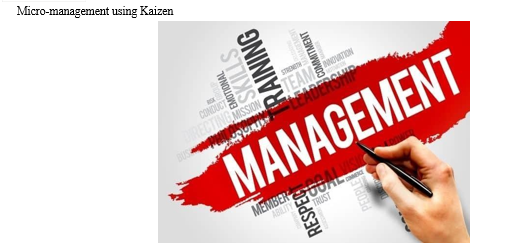
Originating from the fusion of the Japanese characters meaning "good" and "change," the concept of kaizen is frequently encapsulated by the expression "change for the better." This notion of continuous improvement is exemplified by the saying "take it apart and put it back together in a better way," emphasizing the iterative nature of refinement.
In the realm of implementing lean principles at Amazon, a notable hurdle revolved around optimizing human labour through the enforcement of "standard work." Addressing this challenge, a specialized kaizen team was assigned the task of meticulously scrutinizing processes to pinpoint and rectify any deviations from the established norms. By delineating clear and standardized procedures for the designated tasks, employees were empowered to effect gradual yet impactful enhancements in their daily operations.
Although the impact of a single kaizen adjustment may seem modest on its own, the accumulation of numerous incremental improvements yields a substantial collective effect. Central to Amazon's sustained growth and progress is the perpetuation of this ethos of continuous enhancement, underscoring the organization's commitment to fostering a culture of ongoing development and refinement across all facets of its operations.
When it came to implementing kaizen principles within the company, the fulfilment centre stood out as the primary area of focus. Recognizing the significance of hands-on experience, Jeff Bezos, as part of the comprehensive kaizen training initiative, implemented a unique policy mandating that all senior management personnel within the customer care department dedicate no less than a full day annually within the fulfilment centre's operations. This specific strategy enables these leaders to immerse themselves in the day-to-day tasks and challenges faced by front-line employees, ensuring a deep understanding of the operational dynamics of the centre. By actively engaging with the fulfilment centre's activities, senior management personnel can efficiently address any concerns or issues raised by front-line staff, fostering a culture of responsiveness and continuous improvement across the customer care department. This deliberate approach to experiential learning and operational integration plays a crucial role in promoting the effective application of kaizen principles throughout the organisation, ultimately enhancing the overall performance and service quality within the fulfilment centre and beyond.
Potential Applications of LSS at Amazon (with Industry Data):
- Efficiency of Warehouse:
According to a research study conducted by Lee et al. (2004), which focused on the implementation of Lean Six Sigma (LSS) practices within a manufacturing organization, it was found that this strategic approach led to significant cost savings in terms of inventory management. Specifically, the researchers observed a notable reduction of 15% in inventory holding expenses as a direct result of adopting LSS principles. This finding underscores the potential financial benefits that companies can achieve by integrating Lean Six Sigma methodologies into their operational processes. The study, as detailed in the publication by Gary Z. Wang, Hau L. Lee, and Seung-Hyun Kim in Production and Operations Management (2004), sheds light on the tangible impact that proactive quality management strategies, such as Lean Six Sigma, can have on enhancing business performance and driving operational efficiencies.
Embracing a culture of continuous improvement and waste reduction through Lean Six Sigma not only yields cost advantages like decreased inventory costs but also fosters a culture of data-driven decision-making and innovation within the organization. By leveraging Lean Six Sigma methodologies to streamline manufacturing operations and optimize supply chain management, companies can not only achieve short-term cost savings but also position themselves for sustainable long-term growth and competitive advantage in the marketplace.
Implication: In order to enhance operational accuracy and productivity, it is highly probable that Amazon's vast fulfilment centres have implemented the renowned 5S principles for workplace organization and integrated Kanban systems to streamline their inventory management processes. This strategic approach allows Amazon to effectively minimize errors related to order picking while maximizing overall efficiency within their fulfilment operations. By utilizing the 5S principles, which focus on sorting, setting in order, systematic cleaning, standardizing, and sustaining workplace organization, Amazon can create a well-structured and optimized work environment. Additionally, the implementation of Kanban systems enables Amazon to practice just-in-time inventory management, ensuring that inventory levels are closely monitored and replenished as needed to support a smooth and continuous flow of goods throughout their centres. As a result, this combination of 5S principles and Kanban systems serves as a key strategy for Amazon to uphold high levels of accuracy, efficiency, and customer satisfaction within their fulfilment operations while also supporting their overall business growth and success.
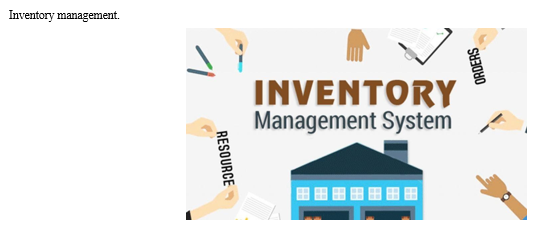
Being customer-focused, the organization transitioned from the initial substance to an ongoing project of managing various types of inventories efficiently in the early days of inventory management. This transition involved the meticulous handling of all stages, from the production of finalized products to the transportation and storage of stock, including stock buffers to prevent stock-outs. The company strategically began accumulating substantial stockpiles in anticipation of customer orders, a practice that not only prevented stock shortages but also allowed it to take advantage of the cost-effectiveness of bulk purchases and the volatile nature of supply and demand. However, as the organization continued to grow, the management of these intricate inventory processes began to incur significant costs in terms of finances, time, and resources. These expenses were further compounded by the need to maintain a high level of customer service, which was largely attributed to the success and popularity of the company.
By 1999, Amazon had solidified its position as a prominent player in the e-commerce sector, largely attributing its success to robust IT infrastructure, strategically located warehouses for efficient order fulfilment, meticulous inventory management practices, and streamlined shipping solutions to meet client expectations promptly and effectively. Over time, the challenge of optimizing storage space and accommodating the increasing volume of goods surfaced as a notable concern. After evaluating various strategies, Amazon decided to outsource certain aspects of their warehouse operations to external partners, aiming to maintain optimal inventory levels and ensure timely delivery of the right products to customers in the right quantities and quality, at the right locations, precisely when needed. This strategic move underscored Amazon's commitment to enhancing operational efficiency while upholding its high standards of customer service, ultimately contributing to the company's continuous growth and success in the competitive e-commerce landscape.
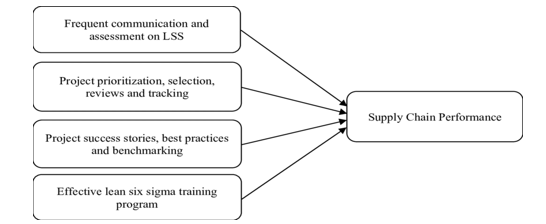
In 2001, Amazon adopted the innovative "Drop Shipment Model" for inventory outsourcing, revolutionizing its operational efficiency. This model streamlined the ordering process by allowing customers to place orders that would then be seamlessly transferred to the retailers for direct shipping to the end consumers. By employing this method, Amazon was able to effectively address logistical challenges while significantly enhancing overall effectiveness.
The significant impact of this strategic shift was unmistakable, with Amazon experiencing a remarkable three-fold increase in its capacity and achieving a noteworthy 20% reduction in warehouse operational costs. These substantial improvements not only paved the way for smoother operations but also played a pivotal role in enhancing Amazon's profit margins. It was a fundamental turning point for the company, driving it towards a new level of success and solidifying its position as a trailblazer in the retail industry. This pivotal decision marked a significant milestone in Amazon's journey towards operational excellence and sustained profitability.
In summary, the strategic use of Lean Six Sigma principles in Amazon's operations is a key factor contributing to the company's remarkable success, as evidenced by its consistent improvement in customer satisfaction rates, profitability margins, and overall quality standards due to the systematic removal of inefficiencies across its operational processes. By adhering steadfastly to these principles, Amazon has been able to elevate its productivity levels in all facets of its operations, showcasing the transformative power of embracing a culture of continuous improvement. The synergy between Lean Six Sigma methodologies and Amazon's operational strategies serves as a compelling case study, offering a vivid demonstration of how these approaches can play a pivotal role in driving operational excellence within a business setting. Furthermore, it underscores the essential need for businesses to prioritize ongoing enhancement and innovation to remain competitive in the dynamic and rapidly evolving landscape of the contemporary business world. As Amazon continues to stand as a vanguard of efficiency and customer-centric operations within the industry, its success story epitomizes the potential benefits of integrating Lean Six Sigma principles into the fabric of an organization's operational framework, establishing a clear roadmap for sustainable growth and enduring success.
X. STRATEGIC VALUE USING LEAN SIX SIGMA
- Cost Reduction: Process waste can be pinpointed and eliminated through the implementation of Lean Six Sigma (LSS) methodologies, resulting in substantial monetary savings for businesses. This strategic approach not only helps in streamlining operational processes but also in optimizing the utilization of available resources, enabling companies to significantly reduce manufacturing costs, enhance overall profitability, and secure a competitive edge in the market against their industry rivals.
- Enhancement of Quality: The adoption of Six Sigma principles places a strong emphasis on reducing errors and variations in business operations, ultimately leading to the delivery of top- notch products and services. This meticulous attention to detail not only translates into higher levels of customer satisfaction but also contributes to the establishment of a reputable brand image and a more robust market position due to the superior quality of offerings provided.
- Operational Efficiency: Through the elimination of non-value-added activities, reduction of lead times, and optimization of production throughput, lean strategies play a pivotal role in promoting operational efficiency within organizations. By streamlining processes and workflows, companies can achieve faster turnaround times, maximize resource utilization, and drive increased production output levels, thereby enhancing operational efficiency across all business functions.
- Focus on the Customer: Lean Six Sigma (LSS) puts a strong emphasis on understanding and meeting customer needs to deliver solutions that not only meet but exceed expectations. By aligning processes with customer demands and preferences, organizations can enhance customer satisfaction, build loyalty, and increase retention rates.
- Culture of Continuous Improvement: Through the adoption of Lean Six Sigma methodologies, organizations cultivate a culture of continuous improvement. Empowering employees to drive innovation, foster creativity, and adapt to changing environments enables long-term success and sustainable growth as they actively identify and resolve challenges.
- Data-Driven Decision-Making: Lean Six Sigma relies on data-driven decision-making to identify root causes of issues, evaluate process efficiency, and track progress in improvement initiatives. By leveraging statistical tools and data analytics technologies, organizations can mitigate risks, seize opportunities for enhancement, and make well-informed decisions that drive positive outcomes and optimize performance.
- Strategic Alignment: The aims and objectives of the organisation are closely matched by Lean Six Sigma (LSS) activities, emphasizing the importance of aligning improvement efforts with overarching strategic priorities. This ensures that resources are allocated efficiently, enabling organisations to maximize the impact of their initiatives in support of strategic goals. By concentrating improvement efforts on critical strategic priorities, businesses can streamline their operations and enhance their overall performance in alignment with their long-term vision and objectives.
- Flexibility and Agility: LSS techniques contribute significantly to fostering flexibility and agility within businesses, empowering them to adapt swiftly to changing consumer needs, market dynamics, and competitive landscapes. This adaptability is crucial for organizations to stay ahead of the curve and thrive in today's rapidly evolving business environments. By continuously modifying and enhancing their processes through the application of LSS principles, companies can not only respond effectively to market shifts but also proactively drive innovation and excellence in all aspects of their operations, ensuring sustained success and competitiveness in the long run.

How to Select a Winning Lean Six Sigma Green Belt Project?
In Six Sigma, the term "belts" signifies the level of expertise and proficiency individuals possess within the methodology, akin to the hierarchical structure in martial arts. These belts reflect the extent of training and capability in applying Six Sigma principles and tools. Selecting a suitable Lean Six Sigma Green Belt project is a crucial aspect of the ongoing enhancement efforts. The process of choosing a project in Lean Six Sigma, including the Green Belt project, emphasizes the importance of measurability and reliance on factual data rather than assumptions.
Linked to Lean Six Sigma projects are the strategic objectives, often referred to as Key Performance Indicators (KPIs), of the organization. These projects are crafted to align with the overarching goals and interests of the organization. By integrating Lean Six Sigma projects with the organization's KPIs, the focus remains on meeting the needs and expectations of clients. The Green Belt project, specifically, addresses a particular issue or challenge with a planned resolution that not only enhances operational efficiency but also contributes to the accomplishment of strategic objectives. Through the application of Lean Six Sigma principles, organizations can strategically tackle issues, improve processes, and enhance overall performance.
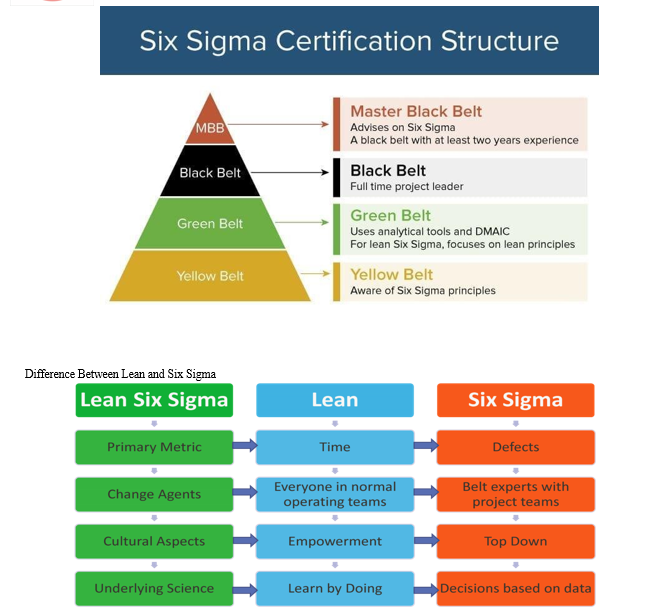
Lean methodologies focus on optimizing processes by eliminating waste and enhancing efficiency across various areas of a business, such as operations, services, and product development. In contrast, Six Sigma primarily concentrates on reducing defects and variability to improve quality. By integrating Lean principles with Six Sigma tools and techniques, organizations can unleash the full potential of both approaches to achieve comprehensive business improvements. This holistic methodology, known as Lean Six Sigma, empowers companies to tackle inefficiencies, enhance productivity, and drive continuous improvement seamlessly. The synergy between Lean and Six Sigma allows businesses to address challenges not only in manufacturing but also in areas like supply chain management, customer service, and administrative processes. Lean Six Sigma offers a structured framework for identifying opportunities for enhancement, analysing data-driven solutions, and implementing sustainable changes to elevate overall business performance. By leveraging the combined strengths of Lean and Six Sigma, organizations can foster a culture of continuous improvement and drive tangible results that lead to operational excellence and customer value creation.
XI. WHAT ARE THE BUSINESS BENEFITS OF LEAN SIX SIGMA?
- monetary advantages
- Benefits for employees
- Benefits to customers
- competitive advantages
- Long-term advantages in strategy
- Financial Benefits
It doesn't take much to observe how Lean Six Sigma has been applied to produce outstanding financial gains in some of the world's top businesses. Well-known examples include GE, Motorola, and Honeywell, but today's successful Lean Six Sigma programmes are being developed by organisations like Amazon, Apple, Kimberly Clark, Lego, Xerox, BAE, and Hertz.
The projects applicants work on as part of the Lean Six Sigma training programme provide the initial financial advantages. When we mentor candidates, we collaborate with the business to identify projects that are crucial to the operation; as a result, we often aim for a 20x ROI. Therefore, we anticipate that a project will result in an average savings of about $40,000 for a $2000 training.
???????2. Employee Benefits
I can think of two well-used quotations. "Take care of your staff and they will take care of your customers" and "Treat your staff so well they can leave but won't want to" are two proverbs that apply here. Richard Branson on both.
Lean Six Sigma is unquestionably among the most beneficial training programmes you can provide to your staff. In addition to developing a wide range of soft skills, such as change management, critical thinking, and analysis, as well as sophisticated problem-solving, leadership, and influence, the programme helps them advance their business acumen.
Investing in your staff is more important now than it has ever been, and the knowledge and abilities candidates get from project delivery and training enable them to advance as managers and leaders. Nine out of ten respondents to a recent poll we conducted said that learning Lean Six Sigma will help them advance in their professions.
???????3. Customer Benefits
The understanding of the client is the foundation of the entire Lean Six Sigma process. The first lesson candidates learn when examining a process is to determine who the process's client is and what it is that they genuinely want. It is impossible to identify the problems and determine what needs to be done to address them without this knowledge. Even if projects may initially be internal in nature, your customers will eventually notice and feel improvements in the company's performance.
More initiatives that are closer to the consumer can be chosen as the programme develops and moves up the value chain. Lean Six Sigma seeks to increase customer value by eliminating waste from every step of the process.
???????4. Competitive Benefits
The objective is to set yourself apart from the competition as your underlying financial situation improves and customer-focused improvements are driven by engaged staff. We all know that it's far more difficult to get new clients than to keep hold of current ones.
Additionally, lean businesses are significantly quicker and better at responding to changes in consumer needs because of their well-designed, highly flexible processes. Your team will be considerably closer to the client and better able to comprehend and adjust to their needs if there is a constant focus on the consumer. This alone sets your business apart from the competition.
???????5. Strategic Benefits
Businesses that have implemented Lean Six Sigma have shown rapid strategic gains regarding both short- and long-term strategic objectives. The proficiency and instruction acquired at the Green Belt and maybe Black Belt levels enable the swift identification of critical strategic initiatives with a depth of problem-solving aptitude that is essential for their accomplishment.
After receiving this training, the focus is no longer so much on putting out fires and surviving but rather on finding lasting solutions to challenges in order to provide the groundwork for wise investments and the efficient use of time, funds, and resources to realise those long- term strategic goals.

Six sigma Tools and templates
Effective Six Sigma project management requires familiarity with common tools and templates that facilitate work. Everything you require to ensure a seamless deployment is provided in this article.
The overall goal of Six Sigma philosophy and concepts is to raise the calibre of business operations. Six Sigma seeks to achieve near perfection by limiting the number of potential defects to less than 3.4 faults per million with the aid of tried-and-true techniques and templates. A company that even if the company adheres to a predetermined strategy, it might not be able to provide high-quality goods or services if it does not apply Six Sigma tools and templates. An organisation may only strive to make ongoing improvements in the quality of produced items or rendered services using Six Sigma tools and templates.
a. Statistical Tools
Three main categories can be used to classify the many tools and templates used in Six Sigma projects: software tools, judgmental tools, and statistical tools. The Critical Path Method (CPM) is one of the statistical tools used in Six Sigma the most frequently. Although CPM was not specifically created for Six Sigma, it is nonetheless widely used since it can support Six Sigma project management, in contrast to other Six Sigma tools. Many projects are underway at any given moment in organisations, so a schedule is necessary to ensure that all of the projects are finished within the allocated time. CPM aids in the creation of an appropriate schedule that establishes the beginning and ending points of crucial activities in any company process.
With CPM's assistance, the project All other instruments utilised in Six Sigma initiatives fall within the category of analytical instruments that support decision-making. Failure Mode and Effects Analysis (FMEA), for example, is one tool that can be used to assist predict future issues through analytical interpretations. Businesses frequently seek out client input to improve the calibre of the products they produce or the services they provide. This is not simple, nevertheless, as the most frequent issue that businesses deal with is their incapacity to translate clients' imprecise assertions into quantifiable practical requirements. This is where technologies like Kano Analysis and VOC Requirements Translation are useful. Sub- systems like VOC Data Collection and Customer Segmentation enable product managers to plan and execute.
b. Software Tools
Since most software tools are created and developed using statistical concepts and theories, they are comparable to statistical tools. The way they are applied in Six Sigma projects is presumably the only significant distinction. Six Sigma software technologies not only expedite corporate processes but also aid in the removal of process-related errors. This contributes to waste reduction, which raises profit margins for the business.
Among the most often used software tools are Minitab and Six Net Intelligence, the hand tool Six Sigma calculator, Rap Analyst, which streamlines DOE (Design of Experiments) and many other data mining-related tasks.
c. Judgemental tools
Statistical and software tools are not the same as judgmental tools, which are used to support decision-making in Six Sigma project implementation. The Ishikawa Root Cause Analysis Diagram (Fishbone diagram) is one such tool that aids in identifying data collection areas and providing answers to frequently occurring issues.
It also aids in determining the causes of project deviations from expectations and underperformance. The Thought Map, Regulation Diagram, and Brainstorming & Affinity Group Tool are more judgmental tools.

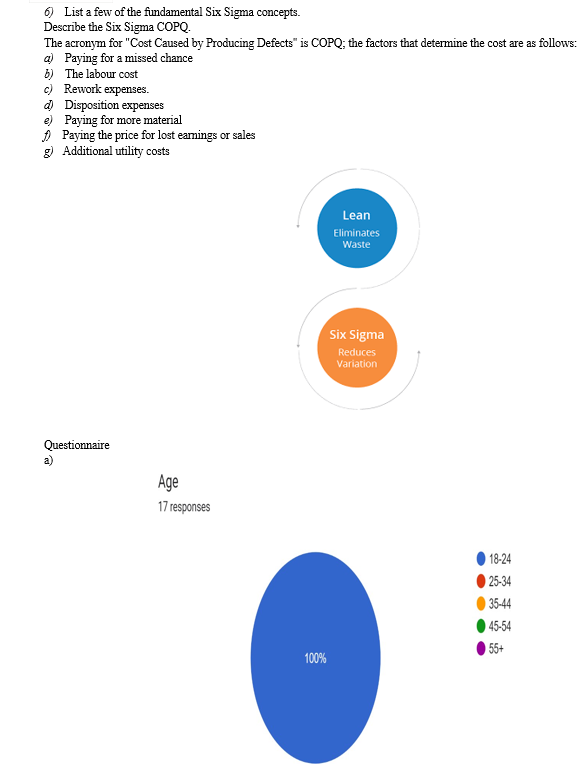
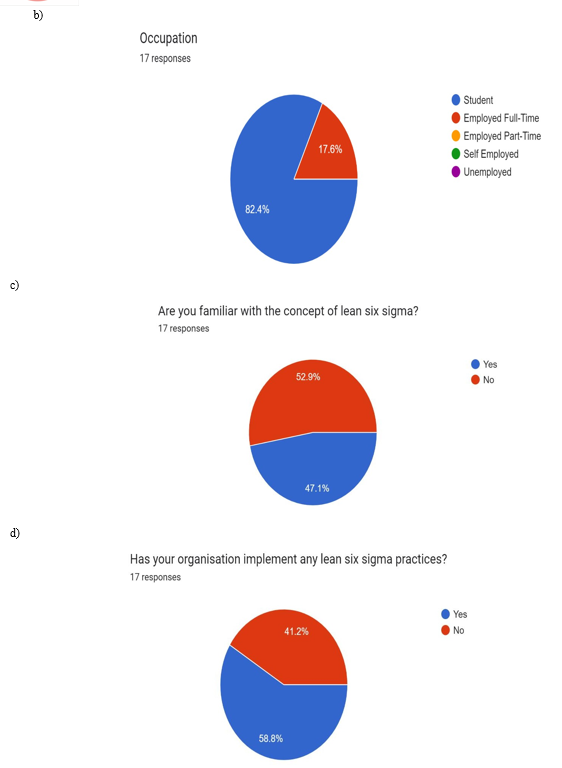
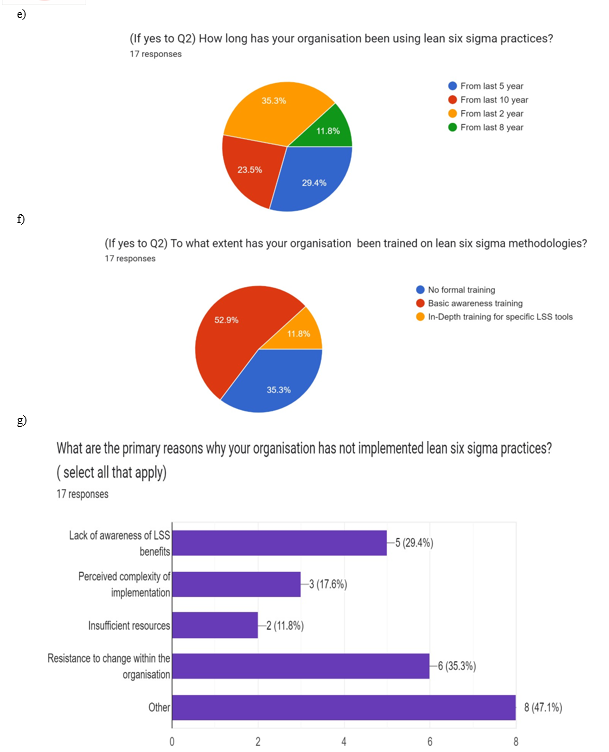
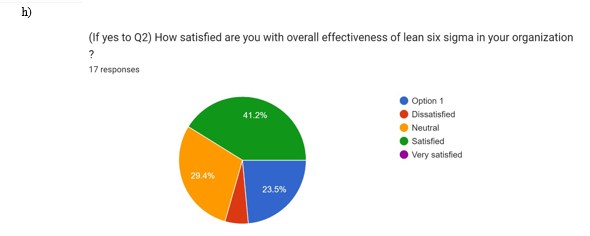
XIII. FINDINGS AND CONCLUSION
Several important conclusions have been drawn from this study on the application of Lean Six Sigma (LSS) for operational excellence:
Studies have consistently demonstrated the significant positive impact of Lean Six Sigma (LSS) principles on operational excellence across various sectors. Numerous research findings have unequivocally pointed towards marked improvements in key operational metrics when organizations adopt LSS methodologies. By implementing LSS practices, businesses have witnessed noteworthy reductions in lead times, defect rates, and costs associated with holding excess inventory. Moreover, a notable upsurge in customer satisfaction levels and workforce productivity has been observed as a direct result of embracing LSS principles. Notable contributions to the understanding of the benefits of LSS in enhancing operational efficiency can be found in the seminal works by Chopra and Sodhi (2004), Lee et al. (2004), and Antony et al. (2007), underlining the widespread recognition and acceptance of the efficacy of LSS across industries. In essence, the evidence overwhelmingly supports the assertion that LSS methodologies are instrumental in driving operational excellence, propelling organizations towards higher levels of performance and competitiveness in today's dynamic business landscape.
Fundamental Ideas: The success of Lean Six Sigma (LSS) hinges on two crucial and interrelated fundamental concepts that form the backbone of its methodology and approach to improving organizational efficiency and quality. Lean Manufacturing, which represents one of these core ideas, entails the systematic optimization of operational processes with the objective of eliminating inefficiencies and non-value adding activities that do not contribute to meeting customer needs or preferences. This involves a holistic examination of workflows, resource allocation, and production techniques to identify and eliminate waste, thereby fostering a leaner, more agile operational framework that is finely tuned to deliver value in a streamlined and efficient manner.
The second fundamental idea vital to the effectiveness of Lean Six Sigma is the concept of Six Sigma itself, which acts as a powerful tool for enhancing quality, consistency, and reliability in organizational processes. Six Sigma methodology focuses on reducing errors, defects, and process variations by leveraging statistical analysis, data-driven insights, and empirical evidence to identify root causes of deficiencies and implement targeted solutions that drive continuous improvement and bolster overall operational performance. By emphasizing a data-centric approach grounded in meticulous analysis and problem-solving techniques, Six Sigma empowers organizations to achieve higher levels of process efficiency, product quality, and customer satisfaction by pinpointing areas of improvement with precision and implementing tailored strategies to address them successfully.
Together, these two core principles of Lean Manufacturing and Six Sigma converge to form the foundation upon which Lean Six Sigma stands, embodying a comprehensive and synergistic methodology that blends the principles of waste reduction, process optimization, and quality management to create a holistic framework for organizational excellence. By combining the lean principles of operational efficiency and waste elimination with the statistical rigor and problem-solving prowess of Six Sigma, Lean Six Sigma fosters a culture of continuous improvement, innovation, and adaptability that enables organizations to thrive in today's dynamic and competitive business landscape. Through the judicious application of these fundamental ideas, organizations can achieve tangible results in terms of enhanced productivity, cost savings, quality enhancement, and customer satisfaction, positioning themselves for sustained success and growth in the long term.
Applications: There are several operational domains in which LSS can be used.
Optimisation of the supply chain involves reducing bottlenecks, optimising inventory levels, and streamlining procedures.
Using 5S concepts and Kanban methods to improve organisation and decrease errors can increase warehouse efficiency.
Enhancing customer service by analysing complaints to find the sources and make the resolution procedures better.
Success Elements: The following are essential elements for an effective LSS implementation:
Strong commitment from the leadership: Employee engagement and resource allocation depend on management buy-in.
Employee involvement and training: It's critical to provide LSS tools to staff members and promote a continuous improvement mindset.
Project focus and selection: It's critical to choose initiatives with specific objectives that complement organisational strategy.
Change management: It's critical to communicate effectively and respond to staff concerns during the implementation phase.
Case Studies: Amazon and Flipkart (Limited Data)
Although there are limited specific details available concerning the utilization of Lean Six Sigma (LSS) techniques at Amazon and Flipkart, historical evidence strongly suggests the feasibility of implementing such methodologies within their operational frameworks.
In the case of Amazon, the company's notable commitment to cultivating a highly skilled workforce through rigorous training programs, fostering a culture of data-driven decision- making, and prioritizing continuous improvement aligns closely with the fundamental principles of Lean Six Sigma. Furthermore, when considering the broader context of industry data that underscores the myriad benefits associated with LSS integration, the potential applications within Amazon's operations span across critical areas such as demand forecasting, enhancing delivery network efficiency, and optimizing warehouse processes for increased productivity and cost-effectiveness.
Turning attention to Flipkart, the prospect of integrating Lean Six Sigma techniques holds significant promise in enhancing the efficiency and effectiveness of their business practices. Notably, the emphasis on streamlining procedures and leveraging LSS methodologies to boost overall performance resonates with Flipkart's strategic focus on operational excellence, particularly within the realms of supply chain management, warehouse operations, and customer service delivery. By strategically implementing Lean Six Sigma strategies, Flipkart stands to gain substantial improvements in process optimization, waste reduction, and quality enhancement, all of which are vital components for achieving operational excellence and sustainable competitive advantage in the ever-evolving e-commerce landscape.
In summary, while specific details regarding the extent of Lean Six Sigma application at Amazon and Flipkart may be scarce, the overarching indicators suggest a strong alignment between the core principles of LSS methodologies and the operational strategies pursued by these industry-leading e-commerce giants. As both companies continue to prioritize operational efficiency, customer satisfaction, and continuous improvement, the adoption of Lean Six Sigma practices presents a compelling opportunity to drive tangible enhancements across various facets of their respective operations, ultimately leading to enhanced performance, streamlined processes, and sustainable growth in today's highly competitive market environment.
XIV. ACKNOWLEDGEMENT
I acknowledge the invaluable assistance of all the faculty members of my college. I would like to show my gratitude to Dr. Gaurav Gupta for allowing me to take this opportunity in doing this project.
I would also like to acknowledge and thank all my friends who participated in this research by providing me with their valuable responses, which formed the basis of this work. I am thankful to all those who, directly or indirectly, assisted me in bringing this project to fruition.
I would like to express my gratitude to my parents for their active cooperation which was a great help during my project.

Conclusion
A potent methodology is provided by Lean Six Sigma to companies aiming to attain operational excellence. Lean Six Sigma, a structured approach that combines Lean manufacturing principles and Six Sigma quality management methodologies, offers a systematic framework for organisations seeking to improve their operational efficiency and effectiveness. This methodology has been widely adopted across various industries due to its proven track record in driving significant improvements in key operational performance indicators. Numerous studies and statistics from the industry support its efficacy in cutting waste, minimising defects, and enhancing a range of operational KPIs. Research findings consistently highlight the positive impact of Lean Six Sigma in streamlining processes, reducing variability, and enhancing overall productivity. The data-driven approach of Lean Six Sigma enables companies to identify root causes of issues, implement targeted solutions, and monitor progress towards achieving operational excellence goals. A strategic strategy with strong leadership commitment, staff engagement, and an emphasis on continual improvement are necessary for successful implementation. Achieving sustainable results with Lean Six Sigma requires more than just adopting the methodology; it demands a culture shift towards a relentless pursuit of excellence and a commitment to ongoing learning and development. Leaders play a crucial role in championing the implementation of Lean Six Sigma initiatives, fostering a supportive environment for employees to engage actively in process improvement efforts. Even though some businesses might not openly promote the usage of Lean Six Sigma (LSS), many top organisations probably incorporate its ideas into their operational excellence initiatives. While not all companies may explicitly advertise their use of Lean Six Sigma, its principles and tools have become ingrained in the best practices of leading organisations seeking to drive operational excellence. The concepts of Lean Six Sigma, such as continuous improvement, waste reduction, and data-driven decision-making, have proven to be fundamental pillars of success for businesses striving to achieve and sustain competitive advantages in today\'s dynamic and demanding marketplace. Organisations across diverse sectors have the valuable opportunity to leverage Lean Six Sigma (LSS) methodologies for significant enhancements in operational performance and overall excellence. By continuously honing and advancing their LSS strategies, businesses can realize substantial and enduring improvements. This strategic approach involves cultivating a culture of efficiency and quality, where the principles of Lean and Six Sigma are integrated seamlessly into operations to drive transformative outcomes. One of the key aspects that businesses can focus on is conducting in-depth case studies of successful LSS implementations to glean valuable insights and best practices. By examining real-world examples of how companies have effectively integrated LSS into their workflows, organisations can acquire practical knowledge that can inform and enhance their own implementation strategies. Moreover, exploring the synergies between Lean Six Sigma and state-of-the-art technologies such as big data analytics and artificial intelligence presents a compelling avenue for further research. By delving into how LSS principles can be harmoniously fused with cutting-edge innovations, organisations can unlock new possibilities for driving operational excellence and achieving competitive advantages through data-driven decision-making and process optimization. Furthermore, investigating the specific challenges and adaptation strategies required for implementing LSS in diverse industry contexts can yield valuable insights for organisations looking to embark on their own LSS journey. By understanding the nuances and nuances of deploying LSS in varied industry settings, businesses can tailor their implementation approaches to effectively address the unique circumstances and demands of their operational environments. In essence, the comprehensive adoption and continuous refinement of Lean Six Sigma practices empower organisations to not only streamline their processes but also foster a culture of continuous improvement and excellence. By embracing the principles of LSS and actively seeking opportunities to enhance their implementation strategies, businesses can position themselves for sustained success and growth in today\'s dynamic and competitive business landscape.
References
[1] Jones, Daniel T., and James P. Womack. Lean thinking: Get rid of waste and make money for your company. 1996 by Simon & Schuster. [2] Pande, Peter S., Cavanagh, Roland R., and Ronald P. Neumann. The Six Sigma revolution: How companies like General Electric are reimagining their operations. 2000; Free Press. [3] Jeju, Michael Youngblood, Ronald S. Antony, S. Christopher, and Antony. \"Lean Six Sigma for service excellence: A case study of a financial service provider.\" 24.9 (2007): 870-883 in International Journal of Quality & Reliability Management. [4] Francisco A. Achua, Andrew R. Soderlund, David R. Clegg, Bryan I. Antony, and Bryan I. Antony. \"The application of Lean Thinking in healthcare: a systematic review of the literature.\" Journal of Quality and Reliability Management International 22.8 (2005): 909– 925. [5] Shafiul Bari, Md. Saiful Alam, Md. Mamuna Rashid, and Chowdhury. \"A review on the application of Lean Six Sigma in the construction industry.\" Manufacturing & Production Research 4.1 (2016): 22–36. [6] Robert G. Schroeder, Carrie M. Meade, and Steven D. Eppinger. \"The effect of Six Sigma project complexity on development speed and success.\" Management of Production and Operations 12.2 (2003): 124–140. [7] Kenneth D. Snee, \"Common pitfalls in Six Sigma implementation.\" 22–28 in Quality Progress 37.2 (2004). [8] Sreedharan, N. Prabhu Raj, S. Narayanan, and Vadakke Pattu S. \"Lean Six Sigma: A literature review and future directions.\" 1.1 (2010): 3–10 in Journal of Operation and Management Research. [9] Jeju Antony, S. Antony, R. Pohlen, and S. Ghobadi an. \"Lean Six Sigma and innovation: A review and research agenda.\" 33.2 (2016): 209-243 in International Journal of Quality & Reliability Management. [10] You can look up news stories, trade journals, or sustainability reports about Amazon and Flipkart\'s operational excellence projects. These could obliquely offer information about possible LSS implementation. https://www.henryharvin.com/blog/amazon-lean-management/ [11] Netland, T.H. (2016), “Critical success factors for implementing lean production: the effect of contingencies”, International Journal of Production Research, Vol. 54 No. 8, pp. 2433-2448. [12] The research \"Company-specific production systems and competitive advantage: a resource- based view on the Volvo production system\" was published in the International Journal of Operations and Production Management in 2013. The authors are T.H. Holland and A. Aspelund. [13] Null, G., Cross, J.A. and Brandon, C. (2019), “Effects of Lean Six Sigma in program management”, Journal of Manufacturing Technology Management, Vol. 31 No. 3, pp. 572- 598. [14] Lang strand, J. and Drotz, E. (2016), “The rhetoric and reality of Lean: a multiple case study”, Total Quality Management and Business Excellence, Vol. 27 Nos 3-4, pp. 398-412. [15] Laureano, A. and Antony, J. (2012), “Critical success factors for the effective implementation of Lean Sigma: results from an empirical study and agenda for future research”, International Journal of Lean Six Sigma, Vol. 3 No. 4, pp. 274-283. [16] Laureano, A. and Antony, J. (2018), “Leadership–a critical success factor for the effective implementation of Lean Six Sigma”, Total Quality Management and Business Excellence, Vol. 29 Nos 5-6, pp. 502-523. [17] Liedtka, J. (2018), “Why design thinking works”, Harvard Business Review, Vol. 96 No. 5, pp. 72-79. [18] Linderman, K., Schroeder, R.G., and Choo, A.S. (2006), “Six Sigma: the role of goals in improvement teams”, Journal of Operations Management, Vol. 24 No. 6, pp. 779-790. [19] Linderman, K., Schroeder, R.G., Zaheer, S. and Choo, A.S. (2003), “Six Sigma: a goal theoretic perspective”, Journal of Operations Management, Vol. 21 No. 2, pp. 193-203 [20] Bhasin, S. (2013), “Impact of corporate culture on the adoption of the Lean principles”, International Journal of Lean Six Sigma, Vol. 4 No. 2, pp. 118-140. [21] Chiarini, A. and Bracci, E. (2013), “Implementing Lean Six Sigma in healthcare: issues from Italy”, Public Money and Management, Vol. 33 No. 5, pp. 361-368. [22] Choo, A.S., Linderman, K.W. and Schroeder, R.G. (2007a), “Method and psychological effects on learning behaviours and knowledge creation in quality improvement projects”, Management Science, Vol. 53 No. 3, pp. 437-450. [23] Choo, A.S., Linderman, K.W. and Schroeder, R.G. (2007b), “Method and context perspectives on learning and knowledge creation in quality management”, Journal of Operations Management, Vol. 25 No. 4, pp. 918-931.Computer Technology Industry Association (2020), “Industry outlook 2021.
Copyright
Copyright © 2024 Prabhat Kumar , Dr Gaurav Gupta . This is an open access article distributed under the Creative Commons Attribution License, which permits unrestricted use, distribution, and reproduction in any medium, provided the original work is properly cited.

Download Paper
Paper Id : IJRASET61131
Publish Date : 2024-04-27
ISSN : 2321-9653
Publisher Name : IJRASET
DOI Link : Click Here
 Submit Paper Online
Submit Paper Online

